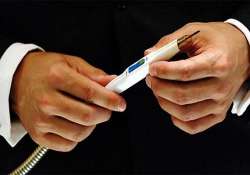London Imperial College researchers invent smart iKnife that can detect cancer in 3 seconds
London: Researchers at the Imperial College, London, led by Dr Zoltan Takats have invented an "intelligent knife" that can tell surgeons immediately whether the tissue they are cutting is cancerous or not in three seconds.

London: Researchers at the Imperial College, London, led by Dr Zoltan Takats have invented an "intelligent knife" that can tell surgeons immediately whether the tissue they are cutting is cancerous or not in three seconds.
The intelligent surgical knife uses smoke from tissue to sense whether or not it is cancerous.
The smoke, which is usually extracted away, is caused by heat from electrosurgical knives that vaporise the tissue as they cut through it.
Dr Zoltan Takats realised this smoke would be rich in the biological information and he connected an electromagnetic knife to a device which can sense the chemicals that hold information about whether the tissue is cancerous or not.
For cancers involving solid tumours, the best treatment is usually to have the tumours removed by surgery, but it's impossible to identify cancerous tissue from non-cancerous tissue by sight.
When surgeons remove tumours, they normally cut away the tissue that's definitely cancerous with a margin of healthy tissue to be sure.
Often tissues are taken away for analysis in the lab while the patient is still under anaesthesia, but this can take up to half an hour.
One in five breast cancer patients undergo up to two operations to make sure all cancerous tissue is removed.
The intelligent surgical knife uses smoke from tissue to sense whether or not it is cancerous.
The smoke, which is usually extracted away, is caused by heat from electrosurgical knives that vaporise the tissue as they cut through it.
Dr Zoltan Takats realised this smoke would be rich in the biological information and he connected an electromagnetic knife to a device which can sense the chemicals that hold information about whether the tissue is cancerous or not.
For cancers involving solid tumours, the best treatment is usually to have the tumours removed by surgery, but it's impossible to identify cancerous tissue from non-cancerous tissue by sight.
When surgeons remove tumours, they normally cut away the tissue that's definitely cancerous with a margin of healthy tissue to be sure.
Often tissues are taken away for analysis in the lab while the patient is still under anaesthesia, but this can take up to half an hour.
One in five breast cancer patients undergo up to two operations to make sure all cancerous tissue is removed.